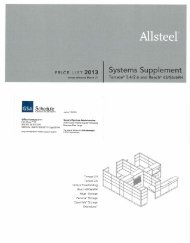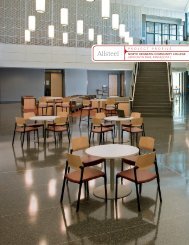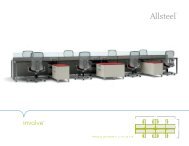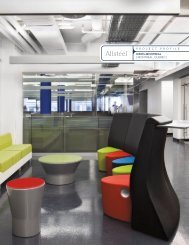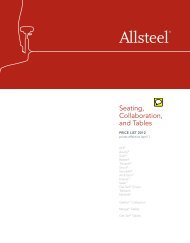The 2008 Workplace Survey - Gensler
The 2008 Workplace Survey - Gensler
The 2008 Workplace Survey - Gensler
You also want an ePaper? Increase the reach of your titles
YUMPU automatically turns print PDFs into web optimized ePapers that Google loves.
KNOWLEDGE WORK equals<br />
FOUR WORK MODES<br />
“Knowledge worker,” a term popularized by management<br />
expert Peter Drucker, refers to an individual<br />
who develops and applies knowledge and information<br />
in the workplace. It is now estimated that knowledge<br />
workers outnumber all other workers in North<br />
America by at least four to one.<br />
While industrial era companies were focused on<br />
task processes and tools to improve speed, efficiency,<br />
and productivity, knowledge economy companies<br />
realize competitive advantage through the creation<br />
of ideas. Knowledge work requires a high level of<br />
cognitive involvement as well as analytical and<br />
judgment skills; process remains important but<br />
is far less structured. Knowledge work is also<br />
a composite of individual and collective modes.<br />
<strong>The</strong> overview of work modes below codifies these<br />
practices in the new science of work.<br />
FOCUS<br />
collaborate<br />
learn<br />
socialize<br />
Research bears out the value that companies can realize by enabling<br />
their employees to focus better. Separate studies conducted<br />
at MIT and Harvard show that interruptions and distractions are<br />
among the biggest threats to worker concentration. Cognitive<br />
overload—the inability to concentrate due to excessive information—poses<br />
another barrier to productivity. 1<br />
People can make leaps in productive focus if they are granted<br />
distraction-free, protected time to get their individual work done.<br />
Yet while research shows increasing organizational support for<br />
the valuable interactive aspects of knowledge work, the support<br />
may have come at the expense of the individual aspect. 2<br />
<strong>The</strong>se other work modes, as well as modern pressures on real estate<br />
costs, have diminished the quality of the focus mode. Collaboration<br />
and socializing have encroached on focus work by undermining the<br />
ability of the traditional site of focus work—the primary work space—<br />
to support concentrated individual activity due to distraction as<br />
colleagues gather to collaborate or socialize.<br />
Open work environments help to foster interaction and also reduce<br />
real estate footprint, but can also result in the acoustical and<br />
visual distractions that hamper people’s ability to focus. This and<br />
other factors pose a dilemma for organizations looking to balance<br />
focus with other work modes.<br />
Innovation, speed and economic value in a knowledge economy<br />
are derived more and more from “collective intelligence”—the<br />
open sharing, connecting and building on ideas through a group<br />
process. Teams have the potential to offer greater breadth and<br />
creativity than any one individual can offer, resulting in innovative<br />
and comprehensive solutions and ideas. 3<br />
Teamwork exists in many different shapes and forms, and varies<br />
across important dimensions. Teams require the ability to interact<br />
with each other to achieve objectives through a shared understanding<br />
of resources, such as members’ knowledge, skills, and experiences,<br />
and explicit goals and objectives. Research shows that effective<br />
teamwork also involves interactions with tasks, tools, and machines. 4<br />
Knowledge creation is another important outcome of collaboration.<br />
Research at MIT found that people were five times more likely<br />
to turn to another individual for information than to search a nonhuman<br />
source such as a file or database, pointing to the value of<br />
interactive work as a business asset. It is estimated that over 70%<br />
of what people know about their jobs is gained through everyday<br />
interactions with their colleagues. 5, 6<br />
Research has definitively linked environments characterized by<br />
visibility, openness, and greater worker mobility to effective<br />
collaboration. Proximity and visual contact help people interact<br />
frequently and build relationships that help them share information,<br />
think creatively, and reach more innovative solutions. This<br />
was echoed in <strong>Gensler</strong>’s 2006 workplace survey that correlated<br />
collaboration with innovation. 7<br />
Knowledge economy companies are increasingly aware that the<br />
success of their people is determined by not just what they know<br />
but how fast they can learn and share their learning. <strong>The</strong> American<br />
Society for Training and Development found that U.S. organizations<br />
spent $109.25 billion annually on employee learning and development,<br />
with roughly 75% of that spent on internal learning programs.<br />
ASTD’s figures also show that the outsourcing of learning is on<br />
the decline, while investment in proprietary learning technologies<br />
is growing. 8<br />
Learning must be integrated into all aspects of a job because<br />
of the constant demands of change and the need for increasingly<br />
skilled workers, which traditional education cannot rapidly supply.<br />
In addition, companies want to avoid down-time while an<br />
employee trains. For all these reasons, there is tremendous<br />
pressure for workplaces to integrate learning with every aspect<br />
of daily activity. 9<br />
<strong>The</strong> design, development and facilitation of learning at work<br />
requires careful consideration of the context of learning as well<br />
as the learning styles of participants. Researchers have identified<br />
multiple ways adults learn. 10 Each learning style has different<br />
implications for when, how and where learning takes place, and<br />
suggests variations in the physical environments required<br />
to support them, challenging organizations to create not just<br />
discrete spaces where people learn, but entire workplaces that<br />
support varied employee needs.<br />
Structured learners<br />
Prefer teacher-directed, highly structured programs with explicit<br />
assignments that are assessed by the instructor; lectures and tutorials<br />
Collaborative learners<br />
Discussion-oriented with a preference for group projects, collaborative<br />
assignments and social interaction; role playing<br />
In today’s knowledge economy, the flow of information between<br />
and among people is at a premium. <strong>The</strong> sense of community<br />
developed through building a social collective creates the<br />
pathways of information sharing and establishes the common<br />
values, culture and mission of an organization.<br />
A 2001 report on the changing nature of work by the National<br />
Research Council called attention to the importance of the<br />
relational and interactive aspects of work, 11 while researchers Cross<br />
and Prusak concluded that knowledge economy success will be<br />
increasingly social and relational, with work accomplished through<br />
informal networks more than organizational hierarchies. 12<br />
Social capital refers to the value of the connections among<br />
individuals in a social network and the norms of reciprocity and<br />
trust that arise from these groups. It contributes value by creating<br />
knowledge and new organizational resources that enhance the<br />
potential for individual and collaborative action.<br />
Trust is an essential component of social capital. <strong>The</strong> greater<br />
the level of trust within a community, the greater the likelihood<br />
of cooperation. Similarly, mutually-held values and shared beliefs<br />
are fundamental to the process of collaborative action, and are<br />
closely tied to the flow of information in networks. 13 Social capital<br />
facilitates people’s ability to act on these beliefs and expectations.<br />
Social networks help organizations to solve problems, learn, innovate,<br />
and adapt. <strong>The</strong>y have been cited by researchers as an organizational<br />
advantage because of their capacity to produce new<br />
knowledge. Research has also shown that the differences between<br />
firms, including differences in performance, may stem from<br />
differences in their ability to create and effectively operate as a<br />
social collective. Firms that develop a robust social infrastructure<br />
are likely to be more successful. 14<br />
Independent learners<br />
Prefer to influence the content and structure of individually-directed<br />
learning programs; distance learning, computer or web-based learning<br />
Note: Research references begin on page 36.<br />
6 <strong>Gensler</strong> <strong>2008</strong> <strong>Workplace</strong> <strong>Survey</strong> / United States <strong>Gensler</strong> <strong>2008</strong> <strong>Workplace</strong> <strong>Survey</strong> / United States 7





